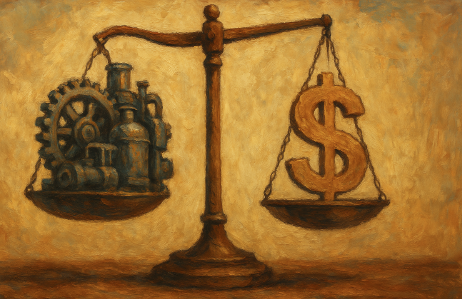
Most people think of capitalism as a system about markets, competition, or even greed. But at its core, capitalism is about capital — specifically, the accumulation of tools that help us make more things, better things, and new things.
Money is capital, but capital isn’t just money. The terms are often used interchangeably, but money is capital in the sense that it is a tool that one doesn’t directly consume, but rather is (or can be) used to create that which we would like to consume.
Critically, money alone doesn’t make us wealthier. Capital, more broadly defined, does.
Capital is what allows our species to convert our finite time and energy into greater output. Machines, software, infrastructure, knowledge and processes — these are what enable us to do more with less. And possessing that power is what really defines wealth.
It’s what multiplies the productivity of human effort. It’s the reason one person with a tractor can do what used to take a hundred with shovels. It’s why someone with a laptop and an internet connection can build a business that serves millions.
Every piece of capital is the result of someone choosing not to consume today, but instead to build something that can be used to produce in the future. That’s the engine of wealth creation. It’s what separates rich countries from poor ones. And it’s also what separates great companies from mediocre ones.
Yet in financial markets, this basic truth is often ignored. Investors get caught up in quarterly earnings, headline profit numbers, or revenue growth rates. But those figures only tell part of the story. A company can grow its revenue and profits rapidly and still be destroying value if it’s chewing through capital faster than it’s creating it.
What really matters is how effectively a business uses its resources; how much value it generates from the tools it has. In plain terms, it’s about how much a company gets back from what it puts in. The better that trade-off, the more valuable the business.
When we lose sight of this, we start rewarding the wrong things. We applaud short-term profit spikes, even if they come at the cost of long-term resilience. We praise companies for growth, even if that growth requires massive spending and endless reinvestment with little return. We treat businesses like machines that can be pushed harder for output, without checking if the engine is overheating or running on fumes.
But the real test is whether that machine is becoming more efficient over time — whether it’s being upgraded, maintained, and made more powerful. That’s what capital accumulation is about. That’s what underscores value.
The distinction between flows and stocks is central here. Flows are the short-term movements: this quarter’s revenue, last year’s net profit, the change in cash from month to month. Stocks are what you build up: the accumulated knowledge, systems, brand strength, distribution networks, and physical tools that make future production possible.
Flows come and go. Stocks persist (or at least they should). And it’s the quality of the stock that determines how strong and sustainable the flows can be.
When we focus only on flows, we risk consuming the very foundation of future value. It’s like celebrating a farmer who boosts his food sales by selling off his seed stock. The revenue looks good today, but he’s just mortgaged the future. That’s what happens when companies cut investment in R&D, gut their workforces, or sell key assets just to meet short-term earnings targets. They’re not creating value — they’re strip mining their capital.
The problem gets worse when the cost of capital feels cheap or distorted. When we stop thinking of capital as scarce, we stop treating it with respect. Money flows freely, speculation runs hot, and the discipline of prudent investment fades. Companies shift from building to optimizing appearances. Investors chase hype instead of productivity.
Eventually, capital gets misallocated — to flashy projects, to fads, to businesses that look good on paper but don’t actually produce anything of lasting worth.
Real wealth comes from what we build, not what we trade. From tools, not tokens. From stocks of capital that let us do more with less. Not just this year, but for years to come.
The best companies are those that grow not just bigger, but stronger. They don’t just increase sales — they improve their ability to generate value from the resources they command. They put time, talent, and money to work in a way that keeps paying off.
That’s what investors should care about. Not how much a business made this quarter, but how well it used what it had. Not whether profits are rising, but whether the business is becoming more productive. Not just whether there’s growth, but whether that growth is durable, efficient, and rooted in something real.
Ignore this, and you’re just riding waves. Understand it, and you’re building ships.
Strawman is Australia’s premier online investment club.
Members share research & recommendations on ASX-listed stocks by managing Virtual Portfolios and building Company Reports. By ranking content according to performance and community endorsement, Strawman provides accountable and peer-reviewed investment insights.
Disclaimer– Strawman is not a broker and you cannot purchase shares through the platform. All trades on Strawman use play money and are intended only as a tool to gain experience and have fun. No content on Strawman should be considered an inducement to buy or sell real world financial securities, and you should seek professional advice before making any investment decisions.
© 2025 Strawman Pty Ltd. All rights reserved.







